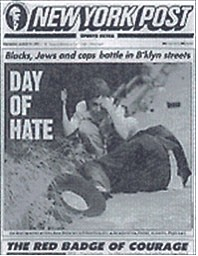
(See related pages)
In some communities, these pockets or enclosures exist on the outskirts of the city, but in most communities they are inside the city, often in the oldest sections, where deteriorating housing has led the middle-class residents to leave and the poor to move in. Most of these pockets are occupied by minorities. For a long time, any examination of these areas and their problems was ignored by the media. One reason was self-interest. Few inner-city residents bought the goods the media advertised, few read the city daily. Another reason was that any revelation of the economic and social conditions could lead to charges of racism, the response that befell a study in 1965 by Daniel Patrick Moynihan, who warned that the growing numbers of children being born to single black mothers was likely to result in serious social problems.
The murder victimization rate for white males is 9.0, for white females 2.8. For black males, it is 69.2, and for black females 13.5. The Department of Justice estimates that one of every 21 black men can expect to be murdered. Speaking Out The situation led many in minority communities to call for attention to the situation. Rep. John Lewis, a Georgia Democrat, said:
He went on to cite homicide data and illegitimacy rates, and he said that when "schools dare to record the truth, the dropout rates are a continuing disaster." Black children, he said, are the "principal victims of child abuse and neglect. The leading cause of death for black children aged one to four is fire." He said, "Increasingly over the past 30 years, crime and violence have been allowed to run virtually unchecked through poor black communities. ... More and more the most conspicuous models of success were the racketeer, the pimp and the insidious drug dealer. ... It is not only poverty that has caused crime. In a very real sense it is crime that has caused poverty, and is the most powerful cause of poverty today." By the mid-1990s, the conspiracy of silence was broken. The media were describing the tragedies and triumphs of daily life in the ghetto. The New York Times ran a series called "Children of the Shadows." One story tells of Ladeeta, an 18-year-old high school senior, who has "survived almost every plague of adolescence in neighborhoods defined by hopeless girls with babies and angry boys with guns." Her father drank himself to death. Her mother, a crack addict, died of AIDS. Ladeeta ran with a gang of girls that beat and robbed other girls. "Her first job was holding drugs and cash for a major neighborhood crack dealer," the story states. Her grandmother plucked Ladeeta from the street life and sent her to a school where teachers took an interest in her. They are struggling to convince her she can have a future. She wonders: "Sometimes I think, how far am I going to be able to go being female and black—two things against me." |
